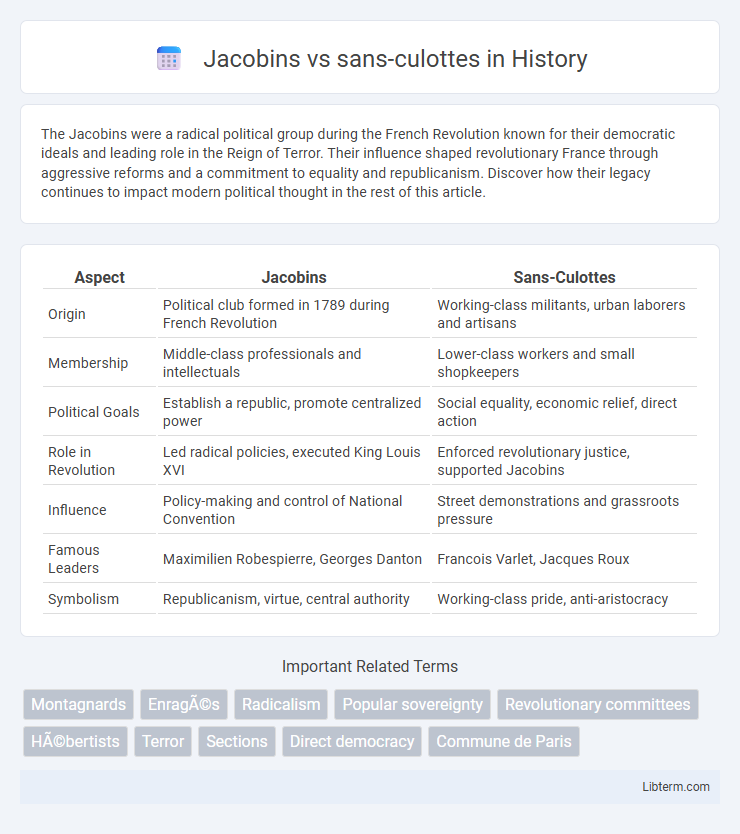The Jacobins were a radical political group during the French Revolution known for their democratic ideals and leading role in the Reign of Terror. Their influence shaped revolutionary France through aggressive reforms and a commitment to equality and republicanism. Discover how their legacy continues to impact modern political thought in the rest of this article.
Table of Comparison
| Aspect | Jacobins | Sans-Culottes |
|---|---|---|
| Origin | Political club formed in 1789 during French Revolution | Working-class militants, urban laborers and artisans |
| Membership | Middle-class professionals and intellectuals | Lower-class workers and small shopkeepers |
| Political Goals | Establish a republic, promote centralized power | Social equality, economic relief, direct action |
| Role in Revolution | Led radical policies, executed King Louis XVI | Enforced revolutionary justice, supported Jacobins |
| Influence | Policy-making and control of National Convention | Street demonstrations and grassroots pressure |
| Famous Leaders | Maximilien Robespierre, Georges Danton | Francois Varlet, Jacques Roux |
| Symbolism | Republicanism, virtue, central authority | Working-class pride, anti-aristocracy |
Introduction: Defining the Jacobins and Sans-Culottes
Jacobins were members of a radical political club during the French Revolution, advocating for centralized republicanism and aggressive measures against perceived enemies of the revolution. Sans-culottes referred to the working-class militants, characterized by their distinctive clothing, who demanded social and economic reforms to improve their living conditions. Both groups played pivotal roles in shaping revolutionary policies, with Jacobins leading legislative changes and sans-culottes driving grassroots activism.
Historical Background of the French Revolution
The Jacobins and sans-culottes emerged as influential groups during the radical phase of the French Revolution, driven by socio-economic inequalities and political unrest between 1789 and 1794. The Jacobins, a political club led by figures like Maximilien Robespierre, advocated for centralized republicanism and strict revolutionary policies to eliminate monarchist and counter-revolutionary threats. Meanwhile, the sans-culottes, composed mainly of working-class Parisians, pushed for more direct democracy, social justice, and radical economic reforms, playing a crucial role in popularizing revolutionary ideals and actions such as the insurrection of August 1792.
Origins and Social Composition of the Jacobins
The Jacobins originated as a political club during the French Revolution, primarily composed of middle-class professionals, lawyers, and intellectuals who advocated for republicanism and radical social reforms. Their social composition contrasted with the sans-culottes, who were mostly working-class artisans, laborers, and small shopkeepers demanding immediate economic relief and popular democracy. The Jacobins' leadership helped mobilize sans-culottes support while steering revolutionary policy through structured political discourse and centralized authority.
Who Were the Sans-Culottes?
The Sans-Culottes were working-class militants in revolutionary France distinguished by their simple trousers instead of the aristocratic knee breeches (culottes), symbolizing their demand for social equality. They were primarily small shopkeepers, artisans, and laborers who pushed for radical economic and political reforms during the French Revolution. Strong allies of the Jacobins, the Sans-Culottes played a crucial role in supporting revolutionary policies and pressuring the government to enact more democratic and egalitarian measures.
Core Ideologies and Political Goals
Jacobins championed centralized republicanism emphasizing the establishment of a strong state to enforce revolutionary principles and eradicate monarchy. Sans-culottes advocated for direct democracy and economic equality, demanding social justice through price controls and wealth redistribution to benefit the working class. Both groups sought to dismantle aristocratic privilege but differed in methods, with Jacobins focusing on political institutions and sans-culottes on grassroots action.
Methods of Political Participation and Influence
The Jacobins utilized organized political clubs and legislative influence within the National Convention to drive revolutionary change, leveraging speeches, debates, and state apparatus control. Sans-culottes engaged directly through grassroots activism, street protests, and popular assemblies, wielding pressure on political leaders to adopt radical policies. Their combined efforts shaped revolutionary politics by blending institutional power with mass mobilization tactics.
Key Figures: Jacobin Leaders vs. Sans-Culottes Spokespersons
Maximilien Robespierre and Georges Danton were prominent Jacobin leaders known for their influential roles in the French Revolution's radical phase. In contrast, the Sans-Culottes were represented by grassroots spokespersons such as Jacques Roux and Jean-Pierre Marat, who vocally championed the working-class demands for social equality and direct action. The Jacobins orchestrated political strategy within the National Convention, while the Sans-Culottes energized popular support through street protests and militant pressure.
Major Conflicts and Collaborations
The Jacobins and sans-culottes frequently clashed over political power and revolutionary strategy during the French Revolution, with Jacobins often seeking centralized control while sans-culottes demanded direct action and social reforms. Both groups collaborated in key events like the overthrow of the monarchy in 1792 and the Reign of Terror, where sans-culottes supported Jacobin-driven policies targeting counter-revolutionaries. Tensions peaked as Jacobins, particularly under Robespierre, attempted to moderate sans-culottes' radicalism, leading to eventual suppression of the popular militants by 1794.
Impact on Revolutionary Policies and Events
Jacobins wielded significant influence over revolutionary policies by advocating for centralized authority and radical reforms, shaping the legislative framework of the French Revolution through the Committee of Public Safety. Sans-culottes, representing the working-class militants, pressured for more direct action, including price controls and social equality, fueling the intense popular support that empowered Jacobin initiatives. The alliance and tensions between Jacobins and sans-culottes catalyzed pivotal events such as the Reign of Terror and the radical shift towards egalitarian laws, fundamentally altering revolutionary governance.
Legacy: Lasting Influence on French and Global Politics
The Jacobins' radical political ideology and centralized revolutionary policies laid the groundwork for modern republicanism and state sovereignty, influencing French political institutions and global revolutionary movements. Sans-culottes, representing the working-class militancy, inspired grassroots activism and social justice demands that echo in contemporary labor rights and populist campaigns worldwide. Together, their combined legacy reshaped notions of popular sovereignty, civic equality, and state power across Europe and beyond.
Jacobins Infographic

 libterm.com
libterm.com